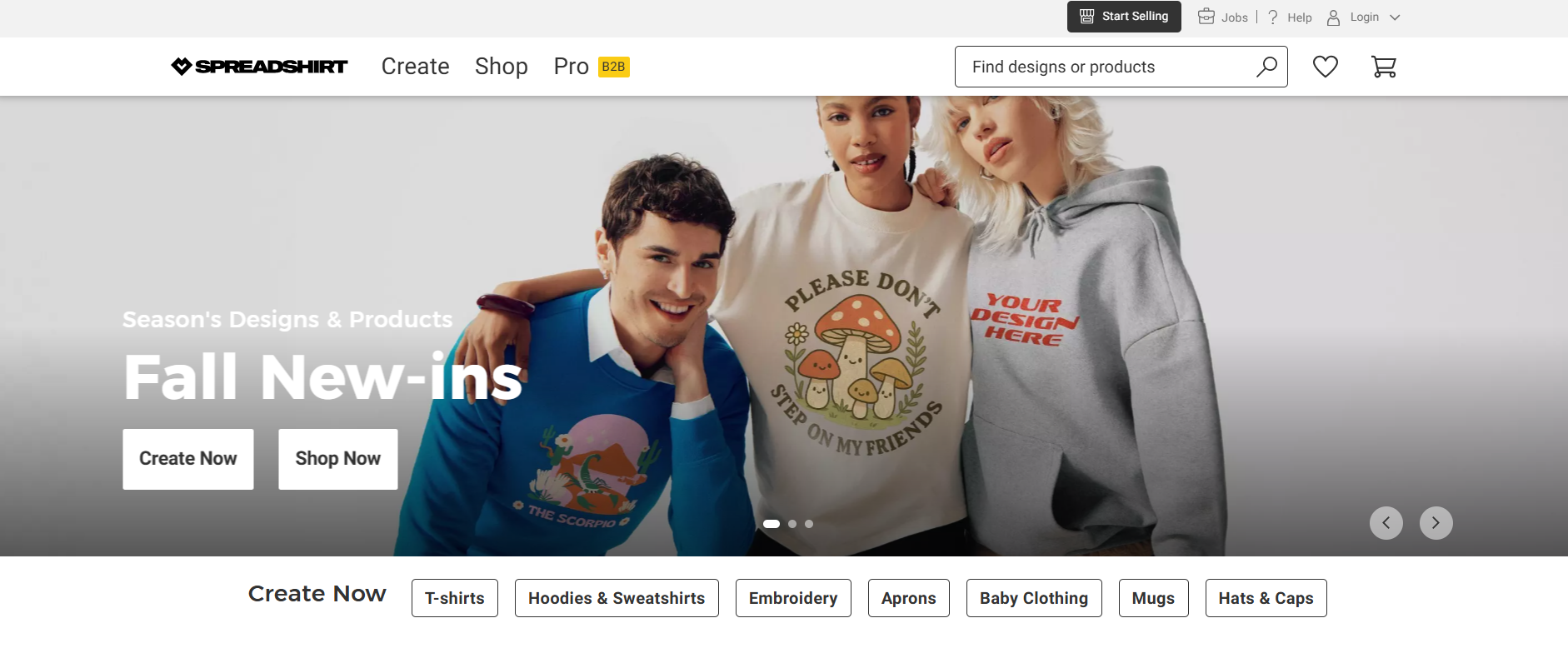Spreadshirt
Spreadshirt is one of the longest-running print-on-demand platforms, offering both a global marketplace and a personal store option for creators. Artists and brands can upload designs to sell across Spreadshirt’s marketplace, or open their own customizable store to reach customers directly. With production centers in Europe and North America, Spreadshirt ensures quality printing, fast shipping, and local fulfillment. It’s ideal for illustrators, meme creators, and small brands who want flexible ways to sell custom apparel and accessories online. Below you’ll find how Spreadshirt works, its features, pros & cons, practical tips, and best alternatives.
How Spreadshirt Works
Spreadshirt offers two main selling options: the Marketplace and the Spreadshop. With the Marketplace, you upload your designs, set tags and categories, and earn commissions whenever someone buys your design on Spreadshirt’s website. With Spreadshop, you can build your own branded storefront — complete with your logo, color scheme, and domain integration. Spreadshirt takes care of printing, fulfillment, and customer service while you focus on design and promotion.
Founded: 2002
Cost: Free to join
Fulfillment: Managed by Spreadshirt’s global production centers
Markets: US, UK, EU, Canada, and beyond
Integrations: Shopify, YouTube Merch Shelf, Twitch, and API
Key Features
Two Sales Models
Sell on the Spreadshirt Marketplace for organic traffic, or open a personal Spreadshop for full branding control.
Global Printing Network
Spreadshirt has fulfillment centers in both Europe and North America for fast, localized shipping.
Creator Tools
Built-in analytics, campaign tracking, and integration tools for influencers and brand owners.
Pros & Cons
Pros
- Established brand with 20+ years of POD experience
- Two flexible selling options: marketplace or personal shop
- Localized printing and shipping for global customers
- Simple setup and artist-friendly royalty model
- Good integrations for creators and influencers
Cons
- Lower profit margins compared to self-managed stores
- Design visibility on marketplace can be competitive
- Storefront customization is somewhat limited
- No direct control over product base pricing
Best For
Creators, influencers, small brands, and illustrators who want to sell custom apparel without managing inventory. It’s especially great for European audiences and creators who want both a personal store and marketplace exposure.
Pricing & Earnings
Spreadshirt’s earnings model varies by platform: on the Marketplace, you earn a fixed commission per sale. In your Spreadshop, you can set your own profit margin above the product base price. Payments are made monthly via PayPal or direct deposit once the payout threshold is met.
Content & IP Guidelines
Spreadshirt enforces strict content policies. Upload only original or licensed designs, and avoid copyrighted logos, characters, or trademarks. The platform performs automatic checks for restricted content to protect both artists and customers.
Practical Tips to Succeed
- Focus on clean, high-contrast vector designs that print well on all apparel types.
- Upload designs in multiple languages for global reach (especially English + German).
- Optimize titles and tags for marketplace SEO and Google Shopping.
- Use both the Marketplace and Spreadshop — they complement each other perfectly.
- Promote your Spreadshop link through social media and creator tools for higher margins.
Where Spreadshirt Fits in Your POD Stack
Spreadshirt is one of the most reliable POD options for European creators and globally-minded artists. Its combination of marketplace traffic and customizable shops makes it a great mid-point between fully managed platforms (like Redbubble) and independent e-commerce setups (like Printful + Shopify).
Alternatives
FAQ
Is Spreadshirt free to use?
Yes. There are no setup or monthly fees. You only earn commissions when your products sell.
What’s the difference between Marketplace and Spreadshop?
The Marketplace offers organic traffic through Spreadshirt’s main site, while Spreadshop gives you your own storefront with branding control.
Where does Spreadshirt ship from?
Orders are printed and shipped from local production facilities in the U.S. and Europe for faster delivery.
